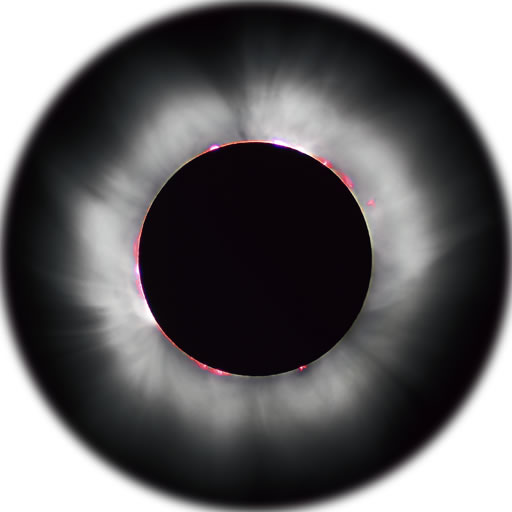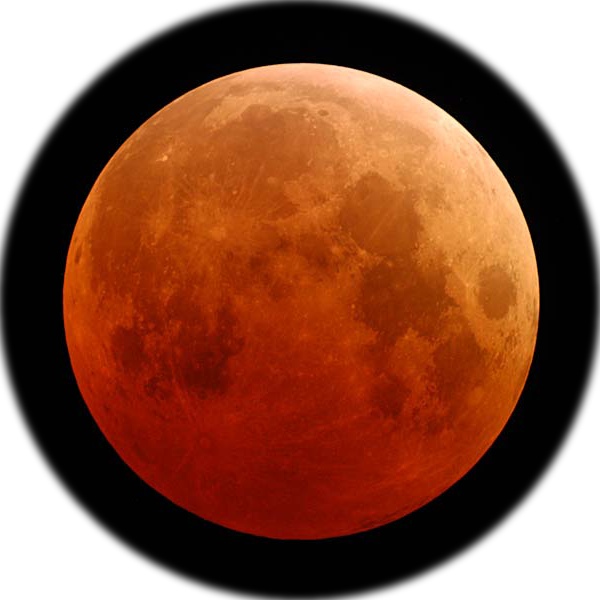Explaining the Phases of the Moon
VISUAL 1 (still): Full Moon
Put up a large still image graphic of the Full Moon, for use with a Moon phase story.

Optional: Tell Egyptian story of the giant pig eating the Moon.
Practically every culture throughout human history has come up with a different explanation in answer to that question. One rather interesting theory was invented by the Egyptians who believed that a new Moon was born each month (literally) and it grew and grew until it was full. At the moment the Moon reached the fullness of maturity, a giant pig attacked it and kept feasting on it for the rest of the month until there was no Moon left, at which time a new Moon was born.
Do you think that’s really how the Moon changes its shape?
Even though we don’t believe this explanation now, in its time this was a perfectly good explanation and accounted for the phases of the Moon quite well.
To see the reason the Moon appears in its various phases, let’s make a working model that shows relationships between the Earth, Sun, and Moon.
Will everyone please stand up?
For the live Moon Phases activity,
turn on the white light (tubular bulb) to about 1/2 brightness.
[VISUALS (alternative movies): Moon Phases
If you do not have the ability to do the live demonstration, you may alternatively use the Moon Phase Activity movies.
See the Moon Phase Movies page to preview the movies as well as download them all. Continuous movies go through all of the Moon phases, whereas other movies are split into segments to show parts of the Moon cycle separately. Split views contain two views of the Moon modelling experience, one from Earth and one from Space. Separate videos for Earth and Space views are also provided for you to place anywhere you like on the dome.]
Let’s pretend that this light is the Sun.
Pretend that your head is the Earth.
All you need to complete the model is the Moon.
[Give each student a ball on a stick. If desired, get volunteers to help hand them out. For larger audiences where you are not using Moon balls, demonstrate how each student can make a model Moon by forming their fist into a ball.]
Hold your Moon so that it is directly in front of the Sun.
Does your Moon look dark? [Yes.]
At this time of month, in reality, the Moon is so dark you could not see it at all. The Moon doesn’t stay in one place; it orbits (goes around) the Earth. Slowly move your Moon to your left, just beginning the orbit of the Moon around the Earth (your head). Move the Moon until you see a small part of it lit by the sunlight.
[Go around and check to see each student understands
and is observing the crescent Moon.]
What shape would you call that lit part of the Moon? [Crescent.]
Does it look like the shape of the Moon when we first saw it in the planetarium sky today? [Yes.]
Now continue the Moon in its orbit, moving it slowly to the left, until you see a half disc lit up, which you may recall is the quarter Moon. Notice that when the Sun is setting, from your viewpoint, the first quarter Moon is directly overhead.
Continue moving your Moon in its orbit until you see the gibbous Moon (nearly full). Now try to hold your Moon in a place where it is fully lit and could be called a full Moon.
[Let the students discover the shadows of their heads.
If necessary, hint that they hold their Moons above those shadows.]
We have now modeled the Sun-Moon-Earth system so that we have seen everything that we observed in the planetarium sky. The lit part of the Moon grew from nothing to full and in reality it takes about two weeks for it to do that. However, the Moon does not stop there in its orbit.
What do you think happens as the Moon continues in its orbit?
[It appears to get smaller.]
Try slowly moving your Moon the rest of the way in its orbit around its Earth. Try going slowly through a couple more orbits so you can observe the complete cycle of the phases of the Moon. In reality, it takes about one month for the Moon to complete such a cycle (29.5 days, to be exact; for young students it is fun to refer to this as a “Moonth.”)
Optional
If your head represents the Earth, the shadow of your Moon ball should be only about 1 mm (1/20 inch) wide. On that scale, the light bulb (Sun) should be about a 2.5 km (1.5 mi) away and your arm would have to be 6 m (20 ft) long to hold your Moon ball at the proper distance from your head!
While we have this model working, let’s see if we can explain a couple of other kinds of events that have startled and terrified people through the ages. Hold your Moon right in front of the Sun so that it blocks the Sun.
Optional
VISUAL 2 (still): Solar Eclipse
Show still image of a total solar eclipse. Or run a solar eclipse digital effect if your planetarium has one.

What is the name for the event in which the Moon blocks the Sun? [Solar eclipse.]
While you hold your Moon so that it blocks the Sun, look around the room at the other “Earths” which are other peoples’ heads.
Do you see the shadows of their Moons on them? What phase must the Moon be in for there to be a solar eclipse? [New.]
In the real Sun-Earth-Moon system, that shadow of the Moon on the Earth during a solar eclipse is only about 80 km (50 mi) wide. In comparison, the whole Earth is about 13,000 km (8000 mi) wide. During a total eclipse of the Sun, only people located in that narrow shadow region can see the eclipse.
Optional
VISUAL 3 (still): Lunar Eclipse
Show still image of Lunar Eclipse. Or run a lunar eclipse digital effect if your planetarium system has one.

Now move your Moon around until it moves into the shadow of the Earth (your head).
What is this type of eclipse called? [Lunar eclipse.]
What phase must the Moon be in for there to be a lunar eclipse? [Full.]
People on the whole night time half of the Earth, the half that points away from the Sun, can observe a total lunar eclipse.
Could people who live on the back of your head see the Moon move into the Earth’s shadow?
[No, it’s daytime for them.]
Many more people have seen lunar eclipses than have seen solar eclipses. This is because whenever a lunar eclipse occurs, people on half of the Earth have the opportunity to see it, but to see a solar eclipse, you must be where the comparatively tiny shadow of the Moon sweeps across the Earth.
[Collect Moon balls.]

